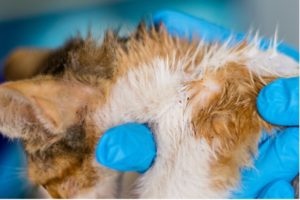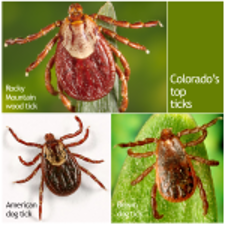We all welcome the spring weather. Unfortunately, with spring, we also must deal with a host of pests. People often refer to the spring and summer as flea and tick seasons even though fleas and ticks are here year-round. But with the arrival of spring, we get outdoors more so we and our pets are more exposed to them. Also, fleas and ticks thrive better during warmer, moist weather. Unfortunately, if not controlled, it can mean health problems for our pets. So it is good to know how to detect them, get rid of them, and prevent them.
How to Detect Fleas and Ticks
Fleas

The first thing you may notice is your pet scratching frequently. While this is often a sign your pet has fleas, pets may also scratch from allergies. Secondly, you may be able to see them crawling through your pet’s fur. Thirdly, and one of the easiest ways to detect fleas is by their “flea dirt”. These are tiny brown or black particles in your pet’s fur. It looks like tiny particles of dirt. The way to tell the difference is by combing your pet with a flea comb and wiping the dirt onto a wet paper towel. If it is flea dirt, it will turn a brown or reddish color. It is the digested blood of your pet that the fleas excrete.

Picture of flea dirt on a wet paper towel by Merck Animal Health
Fleas can quickly jump onto your pet from other animals such as squirrels, rats, opossums, etc. They can also jump onto your clothes and then jump onto your pets. A flea can jump upwards as high as 7 inches and sideways up to 13 inches!
Ticks
Ticks are eight-legged bugs. They have highly developed mouth parts that can pierce the skin of your pet and feed on their blood. Below are the most common tics found in Colorado:

Image of ticks from Colorado Department of Public Health & Environment
Ticks feed on blood to survive and produce eggs. The eggs develop into larvae, then nymphs, and finally, adult ticks. Tick larvae are tiny (the size of a grain of sand). An adult tick can start small (e.g., the size of an apple seed). But as they feed off a pet, they grow in size.

You will most commonly find ticks outdoors in leaf litter, shrubs, or bushes. Ticks also exist in non-wooded areas. You can also find them in tall grasses. Ticks grab on to and cling onto passing animals. For this reason, it is essential to check your pet for ticks after you’ve spent any time outdoors. If you feel a small bump on your pet, be sure to part your pet’s fur and take a closer look.
The Importance of Treating Your Pets for Fleas and Ticks
Both fleas and ticks cause problems with pets, so you never want to take them lightly. A pet can suffer from an allergic reaction from just one single flea bite. Besides, fleas reproduce quickly and abundantly. A female lays up to 50 eggs per day! The video below gives a frightening reality of how fleas can exist in your home without you knowing it.
Fleas can cause skin irritation to your pet. Also, as mentioned above, pets can get allergic reactions to fleas. Newborn kittens and puppies can become anemic from flea bites. In other words, their red blood cell count is low, resulting in internal organ or brain damage. When this occurs, they will typically need a blood transfusion and aggressive flea medication for survival.
Both cats and dogs can get ticks. Here are some basic facts from the Colorado State University:
- The most common tick that bites humans and dogs in Colorado is the Rocky Mountain wood tick.
- Rocky Mountain wood tick is most active and does most biting in spring, becoming dormant with warm weather in summer.
- Colorado tick fever is by far the most common tick-transmitted disease of the region. Despite its name, Rocky Mountain spotted fever is quite rare in Colorado.
Symptoms of Tick Bites in Pets
- Fever
- Weakness
- Lethargy (not wanting to play like normal)
- Loss of appetite
- Shivering
- Unusual panting
- Paralysis
*Tick Paralysis is a rare but potentially severe condition. The paralysis occurs when certain ticks (in Colorado, the Rocky Mountain wood tick) remain attached for an extended period. Early symptoms, such as difficulty walking, progress to more generalized symptoms, such as limb numbness and difficulty breathing. When we remove the tick, this condition is entirely reversible.
The important thing is to contact your vet if your pet is experiencing any of the above symptoms.
How To Get Rid of Fleas and Ticks
Fleas
It takes diligence and persistence to get rid of fleas. Here are steps you can take:
- Treat Your Pet. Contact your veterinarian and find out the proper treatment for your pet. It is important for your pet’s safety that you use the right one.
- Use a powerful vacuum. Vacuum floors, upholstery, and mattresses. Cracks and other tight spaces are usually good hiding places for fleas and their eggs, larvae, and cocoons. If you can, use a vacuum with a bag you can dispose of without coming into contact with its contents.
- Use a steam cleaner for carpets and upholstery, including pet beds. The combination of high heat and soap is the enemy of fleas in all stages of life. Pay special attention to any hot spots where your pet usually lies down.
- Wash all bedding, including your pet’s, in hot water. Dry it at the highest heat setting. If the infestation is severe, consider getting rid of old bedding and starting anew.
- Use flea traps. There are flea traps on the market that can help to eliminate and help prevent flea infestations. One of these is the Victor M230A Ultimate Flea Trap sold by Home Depot and Amazon.
How to Remove Ticks from Pets
There are old myths about how to remove ticks. For example, some people thought you could remove a tick by exposing it to heat. Another is dousing the tick with peppermint oil. It also used to be believed that you had to twist the tick to get it out. These are not safe nor effective methods.
For the safest method watch the video from PetMD below.
How to Get Ticks Off Dogs: How to Kill a Tick and Remove the Head From Your Dog | PetMD

How to Prevent Fleas and Ticks
The best treatment for fleas and ticks is PREVENTATIVE treatment. Various brands of medicine cover both fleas and ticks.
*Important note: make sure you get the proper treatment for your pet, especially for your pet’s weight. Using flea treatment meant for a dog on a cat or giving too high a dose to an animal can be fatal. Check with your veterinarian so you can be sure you are using the proper treatment.
We provide treatment and medications for flea and ticks. If you have any questions or concerns regarding your pet, please contact us here at Amigo Veterinary Clinic in Grand Junction, Colorado.
One Last Word about Spring
As temperatures heat up, pets are at risk for becoming overheated and dehydrated quickly. Here are some basic Dos and Don’ts
DO NOT leave your pet in the car during warm weather. The temperature in a car can heat up rapidly. For example, on an 85-degree day, even with the windows opened; your car can reach 102 degrees in just 10 minutes.
DO NOT leave your dog tied up outside where they do not have access to shade and water.
DO make sure your dog is healthy by making a visit to your veterinarian if you plan a long hike and take plenty of water for both you and your dog.
What's Next
Call us or schedule an appointment online.
Meet with a doctor for an initial exam.
Put a plan together for your pet.

